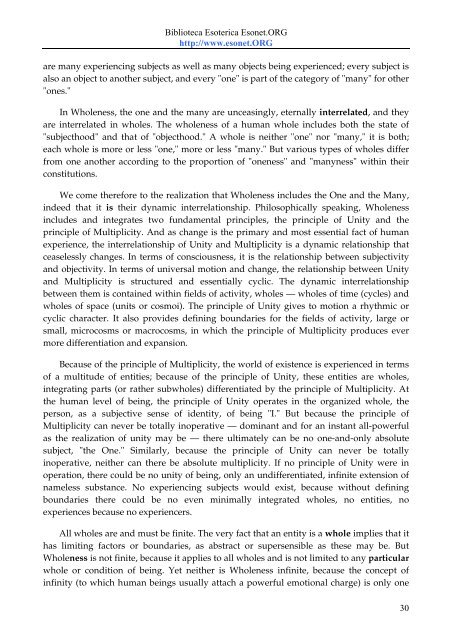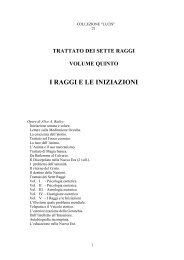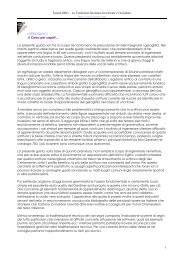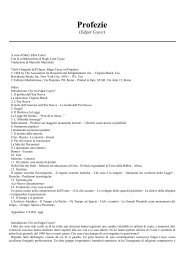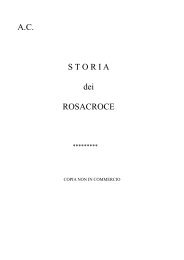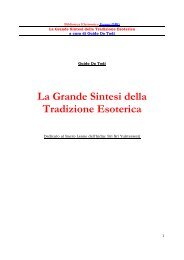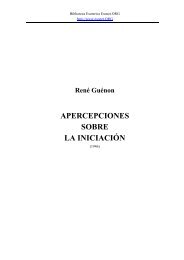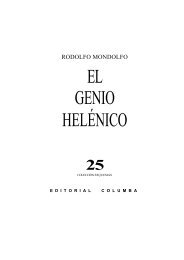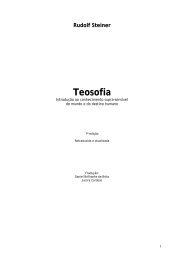Biblioteca Esoterica Esonet.ORG http://www.esonet.ORG 1
Biblioteca Esoterica Esonet.ORG http://www.esonet.ORG 1
Biblioteca Esoterica Esonet.ORG http://www.esonet.ORG 1
Create successful ePaper yourself
Turn your PDF publications into a flip-book with our unique Google optimized e-Paper software.
<strong>Biblioteca</strong> <strong>Esoterica</strong> <strong>Esonet</strong>.<strong>ORG</strong><br />
<strong>http</strong>://<strong>www</strong>.<strong>esonet</strong>.<strong>ORG</strong><br />
are many experiencing subjects as well as many objects being experienced; every subject is<br />
also an object to another subject, and every "one" is part of the category of "many" for other<br />
"ones."<br />
In Wholeness, the one and the many are unceasingly, eternally interrelated, and they<br />
are interrelated in wholes. The wholeness of a human whole includes both the state of<br />
"subjecthood" and that of "objecthood." A whole is neither "one" nor "many," it is both;<br />
each whole is more or less "one," more or less "many." But various types of wholes differ<br />
from one another according to the proportion of "oneness" and "manyness" within their<br />
constitutions.<br />
We come therefore to the realization that Wholeness includes the One and the Many,<br />
indeed that it is their dynamic interrelationship. Philosophically speaking, Wholeness<br />
includes and integrates two fundamental principles, the principle of Unity and the<br />
principle of Multiplicity. And as change is the primary and most essential fact of human<br />
experience, the interrelationship of Unity and Multiplicity is a dynamic relationship that<br />
ceaselessly changes. In terms of consciousness, it is the relationship between subjectivity<br />
and objectivity. In terms of universal motion and change, the relationship between Unity<br />
and Multiplicity is structured and essentially cyclic. The dynamic interrelationship<br />
between them is contained within fields of activity, wholes — wholes of time (cycles) and<br />
wholes of space (units or cosmoi). The principle of Unity gives to motion a rhythmic or<br />
cyclic character. It also provides defining boundaries for the fields of activity, large or<br />
small, microcosms or macrocosms, in which the principle of Multiplicity produces ever<br />
more differentiation and expansion.<br />
Because of the principle of Multiplicity, the world of existence is experienced in terms<br />
of a multitude of entities; because of the principle of Unity, these entities are wholes,<br />
integrating parts (or rather subwholes) differentiated by the principle of Multiplicity. At<br />
the human level of being, the principle of Unity operates in the organized whole, the<br />
person, as a subjective sense of identity, of being "I." But because the principle of<br />
Multiplicity can never be totally inoperative — dominant and for an instant all-powerful<br />
as the realization of unity may be — there ultimately can be no one-and-only absolute<br />
subject, "the One." Similarly, because the principle of Unity can never be totally<br />
inoperative, neither can there be absolute multiplicity. If no principle of Unity were in<br />
operation, there could be no unity of being, only an undifferentiated, infinite extension of<br />
nameless substance. No experiencing subjects would exist, because without defining<br />
boundaries there could be no even minimally integrated wholes, no entities, no<br />
experiences because no experiencers.<br />
All wholes are and must be finite. The very fact that an entity is a whole implies that it<br />
has limiting factors or boundaries, as abstract or supersensible as these may be. But<br />
Wholeness is not finite, because it applies to all wholes and is not limited to any particular<br />
whole or condition of being. Yet neither is Wholeness infinite, because the concept of<br />
infinity (to which human beings usually attach a powerful emotional charge) is only one<br />
30


